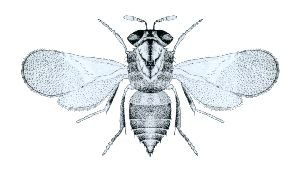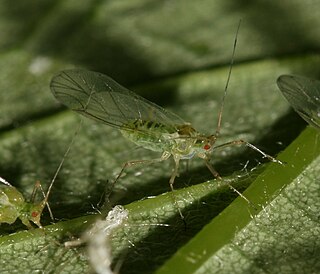
Aphids are small sap-sucking insects and members of the superfamily Aphidoidea. Common names include greenfly and blackfly, although individuals within a species can vary widely in color. The group includes the fluffy white woolly aphids. A typical life cycle involves flightless females giving live birth to female nymphs—who may also be already pregnant, an adaptation scientists call telescoping generations—without the involvement of males. Maturing rapidly, females breed profusely so that the number of these insects multiplies quickly. Winged females may develop later in the season, allowing the insects to colonize new plants. In temperate regions, a phase of sexual reproduction occurs in the autumn, with the insects often overwintering as eggs.
Galls or cecidia are a kind of swelling growth on the external tissues of plants. Plant galls are abnormal outgrowths of plant tissues, similar to benign tumors or warts in animals. They can be caused by various parasites, from viruses, fungi and bacteria, to other plants, insects and mites. Plant galls are often highly organized structures so that the cause of the gall can often be determined without the actual agent being identified. This applies particularly to insect and mite plant galls. The study of plant galls is known as cecidology.
Citrus tristeza virus (CTV) is a viral species of the genus Closterovirus that causes the most economically damaging disease to its namesake plant genus, Citrus. The disease has led to the death of millions of Citrus trees all over the world and has rendered millions of others useless for production. Farmers in Brazil and other South American countries gave it the name "tristeza", meaning sadness in Portuguese and Spanish, referring to the devastation produced by the disease in the 1930s. The virus is transmitted most efficiently by the brown citrus aphid.

Parasitoid wasps are a large group of hymenopteran superfamilies, with all but the wood wasps (Orussoidea) being in the wasp-waisted Apocrita. As parasitoids, they lay their eggs on or in the bodies of other arthropods, sooner or later causing the death of these hosts. Different species specialise in hosts from different insect orders, most often Lepidoptera, though some select beetles, flies, or bugs; the spider wasps (Pompilidae) exclusively attack spiders.

Paraneoptera or Acercaria is a superorder of insects which includes lice, thrips, and hemipterans, the true bugs. It also includes the extinct order Permopsocida, known from fossils dating from the Early Permian to the mid-Cretaceous.
Aphelinus certus is a parasitoid wasp native to Asia. It parasitizes the soybean aphid and other aphids.

Aphelinus is a genus of parasitoid wasps. Several species in the genus parasitize agricultural pests, such as the soybean aphid or the Russian wheat aphid.

Aphelinus mali is a parasitoid wasp that exploits the woolly apple aphid, a pest of apple trees. It is native to the northeastern United States but has been introduced to other parts of the world as a biological pest control agent.

Aphis gossypii is a tiny insect, an aphid ("greenfly") in the superfamily Aphidoidea in the order Hemiptera. It is a true bug and sucks sap from plants. It is a widely distributed pest of a variety of agricultural crops in the families Cucurbitaceae, Rutaceae and Malvaceae. Common names include cotton aphid, melon aphid and melon and cotton aphid.

The black bean aphid is a small black insect in the genus Aphis, with a broad, soft body, a member of the order Hemiptera. Other common names include blackfly, bean aphid, and beet leaf aphid. In the warmer months of the year, it is found in large numbers on the undersides of leaves and on the growing tips of host plants, including various agricultural crops and many wild and ornamental plants. Both winged and wingless forms exist, and at this time of year, they are all females. They suck sap from stems and leaves and cause distortion of the shoots, stunted plants, reduced yield, and spoiled crops. This aphid also acts as a vector for viruses that cause plant disease, and the honeydew it secretes may encourage the growth of sooty mould. It breeds profusely by live birth, but its numbers are kept in check, especially in the later part of the summer, by various predatory and parasitic insects. Ants feed on the honeydew it produces, and take active steps to remove predators. It is a widely distributed pest of agricultural crops and can be controlled by chemical or biological means. In the autumn, winged forms move to different host plants, where both males and females are produced. These mate and the females lay eggs which overwinter.

Macrosiphum euphorbiae, the potato aphid, is a sap-sucking pest insect in the family Aphididae. It infests potatoes and a number of other commercially important crops.
Aphelinus asychis is a parasitoid wasp native to Eurasia that was introduced to North America to control the Russian wheat aphid. It has six different aphid hosts, including Acyrthosiphon pisum.
Elleipsisoma is a genus of parasites within the phylum Apicomplexia.

Aphis spiraecola is a species of aphid described in 1914 by Edith Marion Patch. Its common names include green citrus aphid, Spirea aphid, and apple aphid. It is distributed worldwide, and is most abundant in the United States. It has a diploid chromosome number of 2n=8.

Eriosoma lanigerum, the woolly apple aphid, woolly aphid or American blight, is an aphid in the superfamily Aphidoidea in the order Hemiptera. It is a true bug and sucks sap from plants.
Edward M. Barrows is a biologist who earned his BS in Botany and Zoology at the University of Michigan, Ann Arbor, in 1968, and his PhD in entomology, mentored by Charles Duncan Michener, at the University of Kansas, Lawrence in 1975. Further, he is a retired U.S. Army officer. He has had a lifetime interest in nature, science, and art. He performed research on bee nesting, predation, and reproductive behavior, for example, finding that female Lasioglossum zephyrus sweat bees have individual odors perceived by conspecific males. This was evidently the first discovery of invertebrate individual odors, as opposed to group or nest odors. He later found that males of the Xylocopa virginica virginica have highly complex mate searching and mate-acquisition behaviors, perhaps more complicated that any other bee species and many other animal species. Students and he studied feeding behavior and recovery from injuries in Mimus polyglottos. With students and established scientists, he studied or is studying arthropod community structure in a rare, freshwater, tidal, marsh, and associated habitats, evolution of floral display in Asclepias syriaca, parasitization and reproductive behavior of chalcidoid wasps, floral associates of rare plants, and other topics. His research in scientific communication led to the book Animal Desk Reference, A Dictionary of Animal Behavior, Ecology, and Evolution. His current research laboratory, the Laboratory of Entomology and Biodiversity, is in the Heyden Observatory of Georgetown University.

Cospeciation is a form of coevolution in which the speciation of one species dictates speciation of another species and is most commonly studied in host-parasite relationships. In the case of a host-parasite relationship, if two hosts of the same species get within close proximity of each other, parasites of the same species from each host are able to move between individuals and mate with the parasites on the other host. However, if a speciation event occurs in the host species, the parasites will no longer be able to "cross over" because the two new host species no longer mate and, if the speciation event is due to a geographic separation, it is very unlikely the two hosts will interact at all with each other. The lack of proximity between the hosts ultimately prevents the populations of parasites from interacting and mating. This can ultimately lead to speciation within the parasite.

Profenusa thomsoni, the amber-marked birch leaf miner, is a species of sawfly in the family Tenthredinidae. It is native to the Palearctic realm but has spread to North America. The larvae feed on the foliage of birch trees.
Drepanosiphum is a genus of true bugs belonging to the family Aphididae.

Drepanosiphum platanoidis is a species of insect, commonly known as the sycamore aphid. It undergoes both parthenogenic and sexual reproduction.











